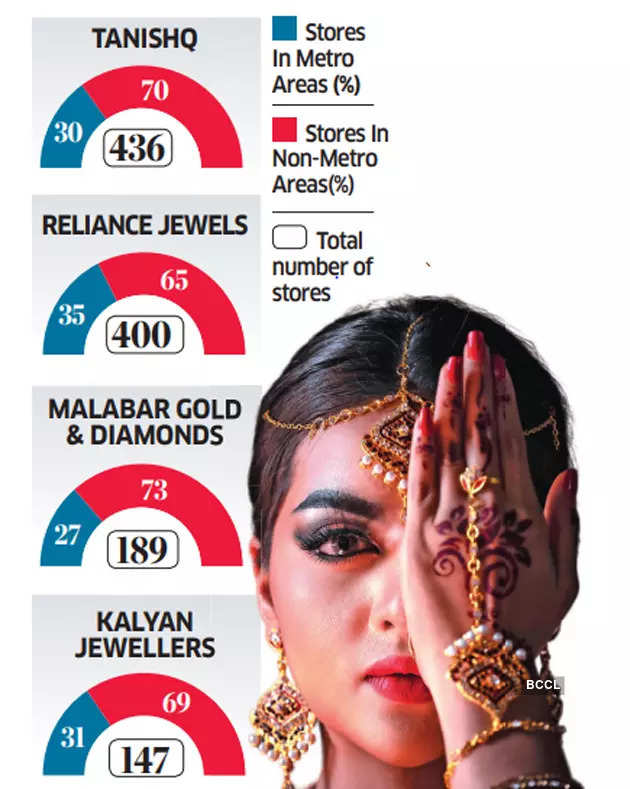Kolkata | New Delhi: Latha Radhakrishnan used to travel to Coimbatore city to buy gold jewellery from Tanishq‘s store there, but she now has the option to buy it closer home, as the Titan co-owned chain has opened an outlet at Pollachi.
Tanishq’s store at Pollachi, about 40 km south of Coimbatore city and opened in April last year, shows how established jewellery chains are going closer to consumers in small towns who are increasingly opting for branded jewellery with latest designs and proper hallmark unique identification numbers, which ensure purity of gold.
For organised retailers like Tanishq, Malabar Gold & Diamonds and PNG Jewellers, setting up shop in small towns help tap into this growing demand at a lower cost than expanding in big cities, as real estate comes much cheaper.
As much as 70% of Tanishq’s 436 stores are outside large cities – 38% in places with 200,000-plus population and 32% in smaller towns – with the remaining 30% in metros and mini-metros, chief executive Ajoy Chawla said. Some of these are located in places such as Kudal in Maharashtra’s Sindhudurg district, Bhawanipatna and Angul in Odisha, and Mirzapur and Balia in Uttar Pradesh.
A lot of demand, in small towns as well as big cities, is influenced by social media, Bollywood weddings, and content on TV and OTT platforms such as Netflix and Amazon Prime.
The latest craze among the young generation are the emerald necklaces that Kiara Advani and Parineeti Chopra wore at their weddings, said jewellers.
“Customers come with screenshots or show us the reels and ask us to make something that looks similar to what is shown,” said Saurabh Gadgil, chairman of PNG Jewellers, which has 42 stores in Maharashtra and Goa.
Consumers seek distinctiveness in jewellery and branded segments with their unique offerings fulfilling that demand, said MP Ahammed, chairman of Malabar Gold & Diamonds.
The company, which has 189 outlets in India, witnesses this demand not just from big cities, but also from tier-2 and tier-3 cities such as Raipur, Bhopal or Ongole (Andhra Pradesh), he said. “Millennials are always on the move and they aspire to wear branded jewellery,” said Ramesh Kalyanaraman, executive director of Kerala-based Kalyan Jewellers that operates 172 outlets, including 119 in non-metros.
A person with direct knowledge of Reliance Jewel’s plans said the company wants to be well penetrated in the regions. It has decided to expand aggressively because customers are now asking for quality and transparency. The government has also introduced rules that require companies to be compliant with regulations and large companies feel they will finally get a fair deal in the industry, this person added.
Typically, these retailers start small when they enter a town and expand based on market demand. A store in a small town starts with 2,500 square feet of space and within 3-5 years it goes up to 4,000 sq ft. The average revenue from such stores rises from ₹20-30 crore to ₹50 crore a year in this period, said Chawla of Tanishq.
Some of the organised jewellers which are unlisted may go for initial public offering to raise funds as part of their efforts to expand operations. “When a company is listed, the customers find it more trustworthy and transparent and it also helps the company to expand in newer markets,” said Bhargav Vaidya, a Mumbai-based gold trade analyst.

Organised vs unorganised
The desire to give her daughter branded jewellery during her marriage prompted Rita Sihan, a resident of Bhopal, to shift from the neighbourhood jewellery shop to a Malabar Gold store. “I had exchanged my old jewellery and paid a few bucks more to get hallmarked and well-designed jewellery for my daughter as the brides wear in metros,” said Sihan.
She came to know about these designs through social media. At Angul in Odisha, Sunita Mahapatra used to visit her neighbourhood shop to make jewellery. But when Tanishq came to her town, she immediately switched to the organised retailer. “I know I am now getting pure hallmarked gold with designs that are more modern,” she said.
Does this mean the end of the unorganised jewellery sector? Not at all, said industry executives.
“It is true that some have closed down, but many have shifted to proper hallmarking,” said an executive.
According to ICICI Securities, in the medium term, the jewellery segment can outperform (other consumer discretionary segments) as it is relatively immune (inelastic wedding purchases, gold as an investment asset) to a general slowdown in consumer discretionary spending. In August, the jewellery segment grew 14%, outperforming the overall retail sector that expanded 14%, show data from the Retailers Association of India. In 2022, India consumed 777 tonnes of gold, according to the World Gold Council. Of this, gold jewellery accounted for 600.4 tonnes while the rest was towards investment demand.



